Pixel art games have become increasingly popular in recent years, particularly among indie game developers. The use of retro-style graphics, with a limited color palette and large, blocky pixels, can create a nostalgic feel for gamers who grew up in the 8-bit and 16-bit eras. However, pixel art is not just about nostalgia – it can also be a deliberate artistic choice to create a unique aesthetic that sets a game apart from others. Let’s explore some of the fundamental aspects of the art style and Introduce some games that have used this art style the best.
What is a Pixel Art Game?
![]()
![]()
A pixel art game is a video game that uses pixelated graphics to create a retro aesthetic. It is a throwback to the early days of video gaming when graphics technology was limited, and developers had to rely on simple, blocky pixel art to create their games. Today, pixel art games are still popular, not only because they evoke a sense of nostalgia but also because they can create unique, charming, and visually appealing game worlds.
What Genre are Pixel Art Games?
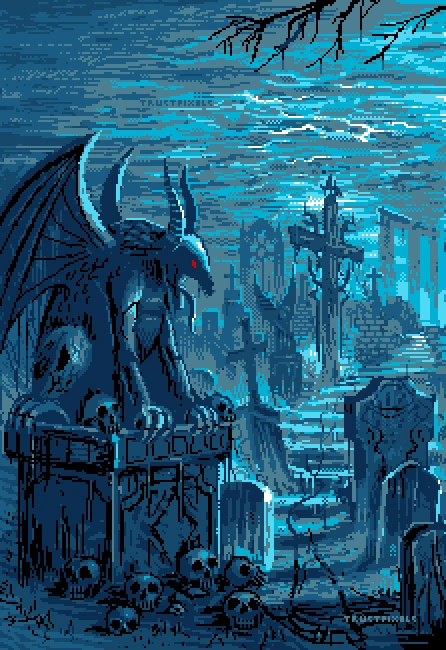

Why can indie game pixel art games span across a variety of genres, including platformers, RPGs, action-adventure games, puzzle games, and more? The use of pixel art is a stylistic choice that can enhance a game’s overall aesthetic and feel, regardless of its genre. Some of the most popular pixel art games include iconic titles such as Super Mario Bros., The Legend of Zelda, and Metroid, all of which fall into different genres.
Why pixel art games are still popular?
Pixel art games continue to maintain their popularity for several reasons, despite the advancements in graphics technology and the rise of photorealistic 3D games. Here are some key factors contributing to the enduring appeal of pixel art:
- Nostalgia: Pixel art evokes a sense of nostalgia for many players, reminding them of classic video games from their childhood. For those who grew up playing games on older consoles such as the NES, SNES, or Game Boy, pixel art can evoke fond memories and a sense of nostalgia for simpler times.
- Timeless Aesthetic: Pixel art possesses a timeless aesthetic that transcends technological limitations. Unlike more realistic graphics, which can become outdated as technology advances, pixel art retains its charm and appeal regardless of hardware limitations.
- Artistic Expression: Pixel art allows for a high degree of artistic expression within a constrained canvas. Artists can create intricate, detailed sprites and environments using limited color palettes and pixel resolutions, showcasing their creativity and skill in a distinctive visual style.
- Accessibility: Pixel art games are often more accessible to indie developers and small studios with limited resources. The simplicity of pixel art allows developers to focus on gameplay mechanics, storytelling, and game design without the need for extensive graphical assets or complex rendering engines.
- Versatility: Pixel art is a versatile medium that can be adapted to a wide range of genres and styles, from retro platformers and RPGs to modern indie titles and mobile games. Its simplicity and flexibility make it suitable for both lighthearted, whimsical experiences and darker, more atmospheric narratives.
- Performance: Pixel art games tend to have lower hardware requirements compared to their 3D counterparts, making them accessible to a broader audience of players, including those with older or less powerful hardware.
In summary, the enduring popularity of pixel art games can be attributed to their nostalgic appeal, timeless aesthetic, artistic expression, accessibility, versatility, and performance benefits.
What is pixel art in games?
Pixel art is a style of digital art characterized by its use of small, distinct square pixels to create images, characters, and environments. In the context of video games, pixel art refers to the use of pixelated graphics to depict game assets, including sprites, backgrounds, and animations.
Pixel art originated in the early days of video game development when hardware limitations necessitated the use of low-resolution graphics. Despite the constraints imposed by limited color palettes and pixel resolutions, pixel art artists were able to create visually striking and expressive artwork using clever techniques such as dithering, shading, and color contrast.
In pixel art games, each pixel serves as a building block for creating detailed and intricate visuals. Artists carefully arrange pixels to form characters, objects, and environments, paying close attention to composition, perspective, and color theory. The result is a distinctive visual style characterized by crisp lines, bold colors, and charming simplicity.
Pixel art games encompass a wide range of genres and styles, from retro-inspired platformers and RPGs to modern indie titles and mobile games. Despite the advancements in graphics technology, pixel art remains a popular choice for developers seeking to evoke nostalgia, showcase artistic expression, and create visually captivating gaming experiences.
Why do Indie Games Use Pixel Art?
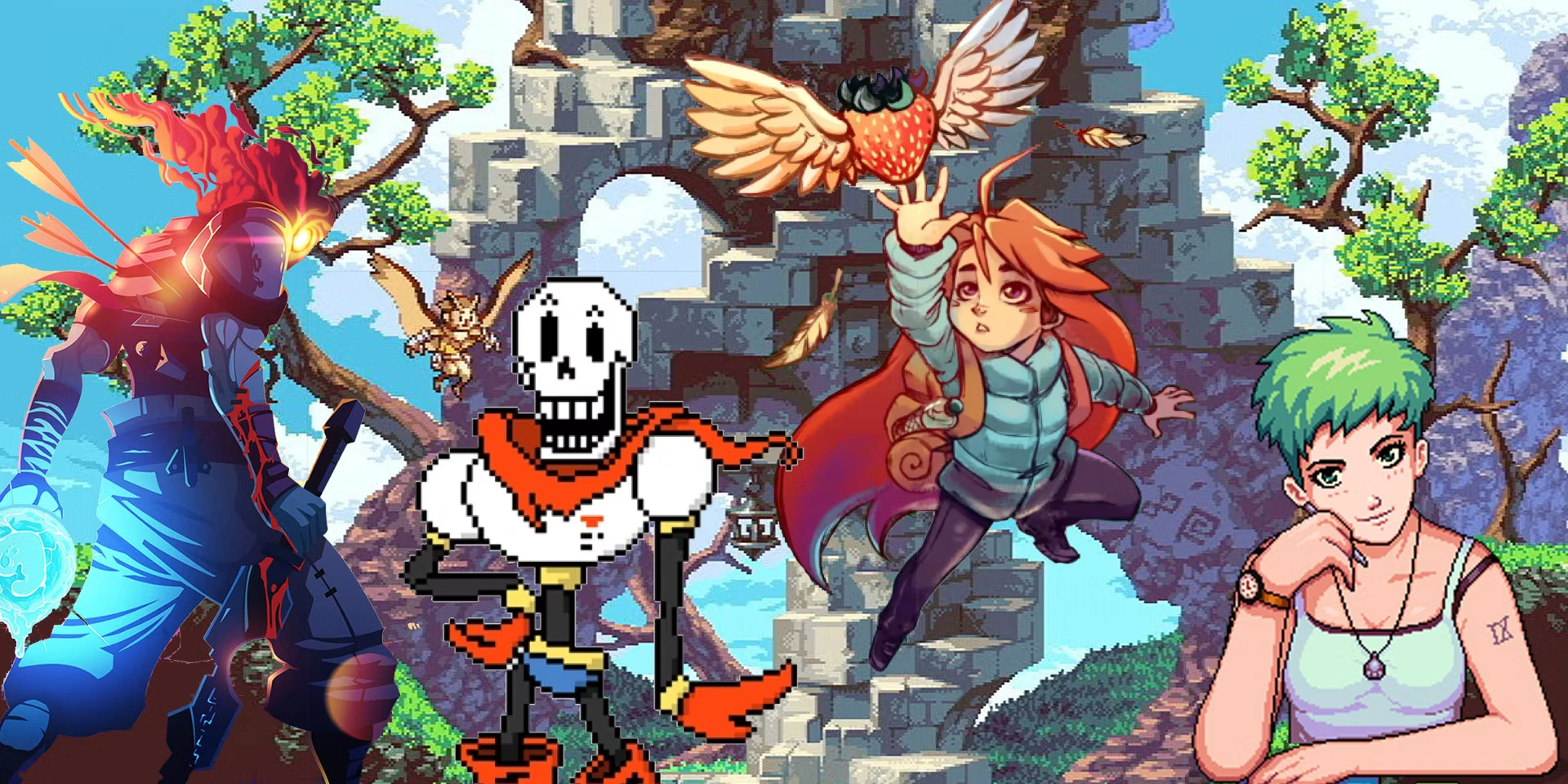

Indie game developers often use pixel art because it allows them to create games with unique aesthetics, often evoking nostalgia or paying homage to classic games of the past. Additionally, pixel art is a relatively easy and inexpensive art style to work with for smaller development teams, as it doesn’t require high-end graphic design software or a large team of artists. Pixel art is also flexible, allowing developers to create games with a wide range of visual styles, from retro-inspired to modern takes on the style.
Pixel art games also tend to have a distinct charm and personality that sets them apart from other games. They can evoke a sense of nostalgia for players who grew up playing games in the 8- and 16-bit eras while offering a unique visual style that is instantly recognizable. For indie developers, pixel art can help their game stand out in a crowded marketplace, attracting attention from players looking for something different or unique. Pixel art is popular among indie game developers due to its versatility, accessibility, and nostalgic appeal.
Read more: Game Dev journey: AAA or Indie?
Best Pixel Art Games in 2023
As technology continues to advance and game graphics become increasingly realistic, there is still something charming and unique about pixel art games. These games rely on the retro style of graphics that were popular in the 8-bit and 16-bit eras of gaming. Even in 2023, many incredible pixel art games have captivated players with their nostalgic visuals and engaging gameplay. Let’s introduce some of them:
Teenage Mutant Ninja Turtles: Shredder’s Revenge
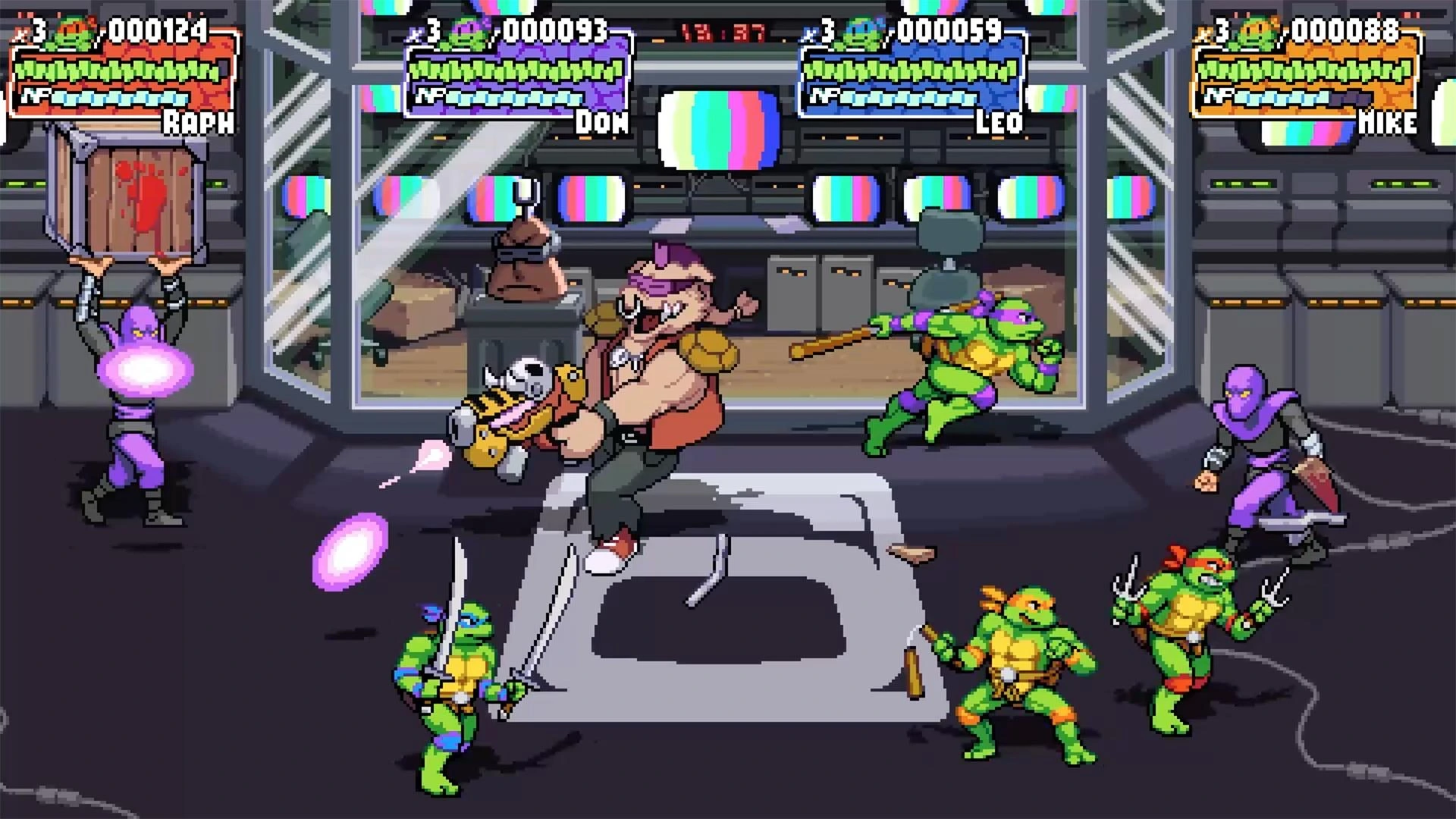

| Release Date | Platforms |
| 2022 | Android, PlayStation 4, PlayStation 5, Nintendo Switch, Xbox One, iOS, Microsoft Windows, Xbox Cloud Gaming, Linux |
Teenage Mutant Ninja Turtles: Shredder’s Revenge is a pixel art beat ’em up game developed by Tribute Games and published by Dotemu. The game takes inspiration from classic TMNT games like Turtles in Time and features classic characters from the series like Leonardo, Donatello, Michelangelo, and Raphael. Players can choose their favourite turtle and fight against Shredder and his minions across various levels.
The game’s pixel art design pays homage to the classic TMNT games of the past, with detailed character sprites and colorful, animated backgrounds. The gameplay is fast-paced and action-packed, with various moves and combos for each turtle. The game also features cooperative play, allowing players to team up with a friend for some couch co-op beat ’em-up action. With its nostalgic design and addictive gameplay, Teenage Mutant Ninja Turtles: Shredder’s Revenge is a must-play for fans of the series and lovers of pixel art games.
Terraria
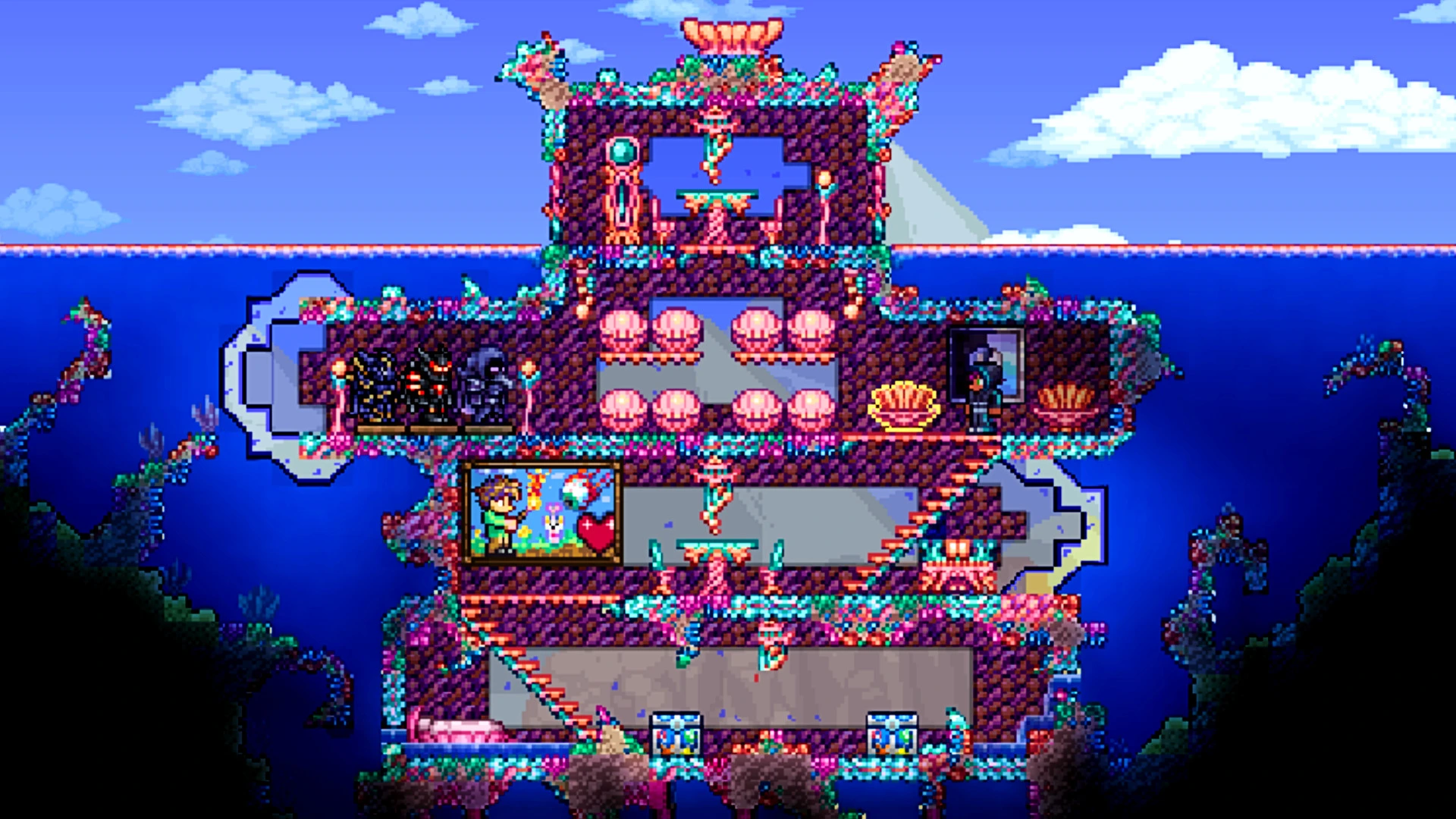

| Release Date | Platforms |
| 2011 | PC and Consoles |
Terraria is a 2D sandbox action-adventure game developed by Re-Logic. The game was initially released for Microsoft Windows in 2011, and since then, it has been ported to various platforms, including macOS, Linux, PlayStation 3, Xbox 360, PlayStation Vita, iOS, and Android.
In Terraria, players explore a procedurally generated world, dig, mine, and build structures while fighting various enemies and bosses. The game features an open-world sandbox gameplay style with RPG elements, such as leveling up, crafting, and loot gathering. Terraria’s retro-style pixel art graphics give the game a unique aesthetic that complements its gameplay mechanics. The game has received critical acclaim for its addictive gameplay, excellent soundtrack, and its constant stream of content updates that keep players engaged.
Enter the Gungeon
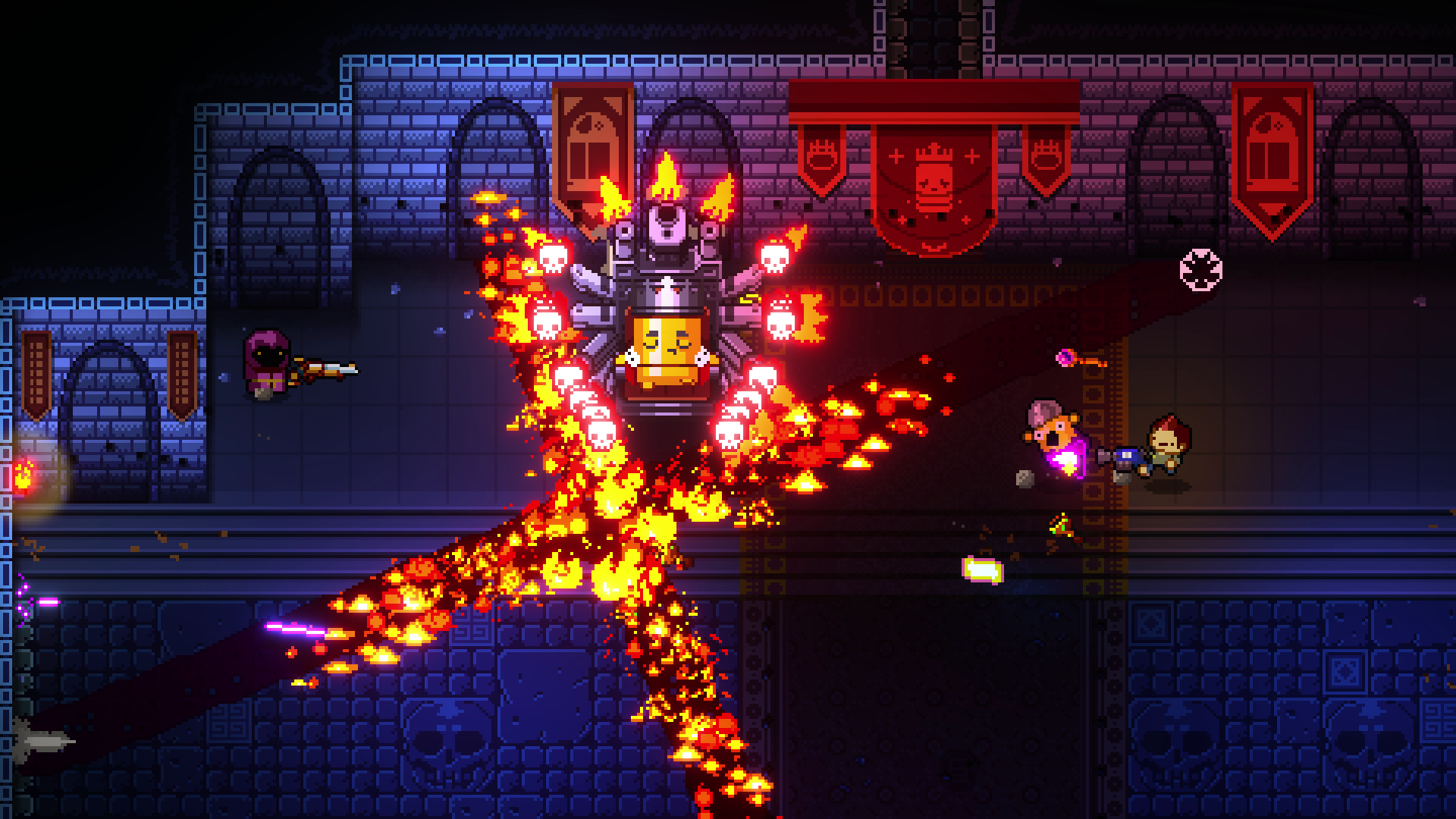

| Release Date | Platforms |
| 2016 | PC, PlayStation 4, Xbox One, Nintendo Switch |
In Enter the Gungeon, players must navigate through randomly generated levels, fighting off hordes of enemies and collecting powerful weapons to progress deeper into the Gungeon. With over 200 different weapons and items, each playthrough offers a new experience. The game also features a cooperative multiplayer mode, allowing players to team up and take on the Gungeon together. Enter the Gungeon has received critical acclaim for its addictive gameplay, replayability, and charming aesthetic.
Hyper Light Drifter


| Release Date | Platforms |
| 2016 | PC, PlayStation 4, Xbox One, Nintendo Switch |
In Hyper Light Drifter, players take on the role of the Drifter, a mysterious figure who travels a world in ruins searching for a cure for an unknown illness. The game features fast-paced combat that requires quick reflexes, strategic thinking, and a sprawling, interconnected world filled with secrets to discover. The game’s hauntingly beautiful visual design and immersive soundscapes add to the overall experience, making it a standout title in the indie game scene.
Shovel Knight: Treasure Trove
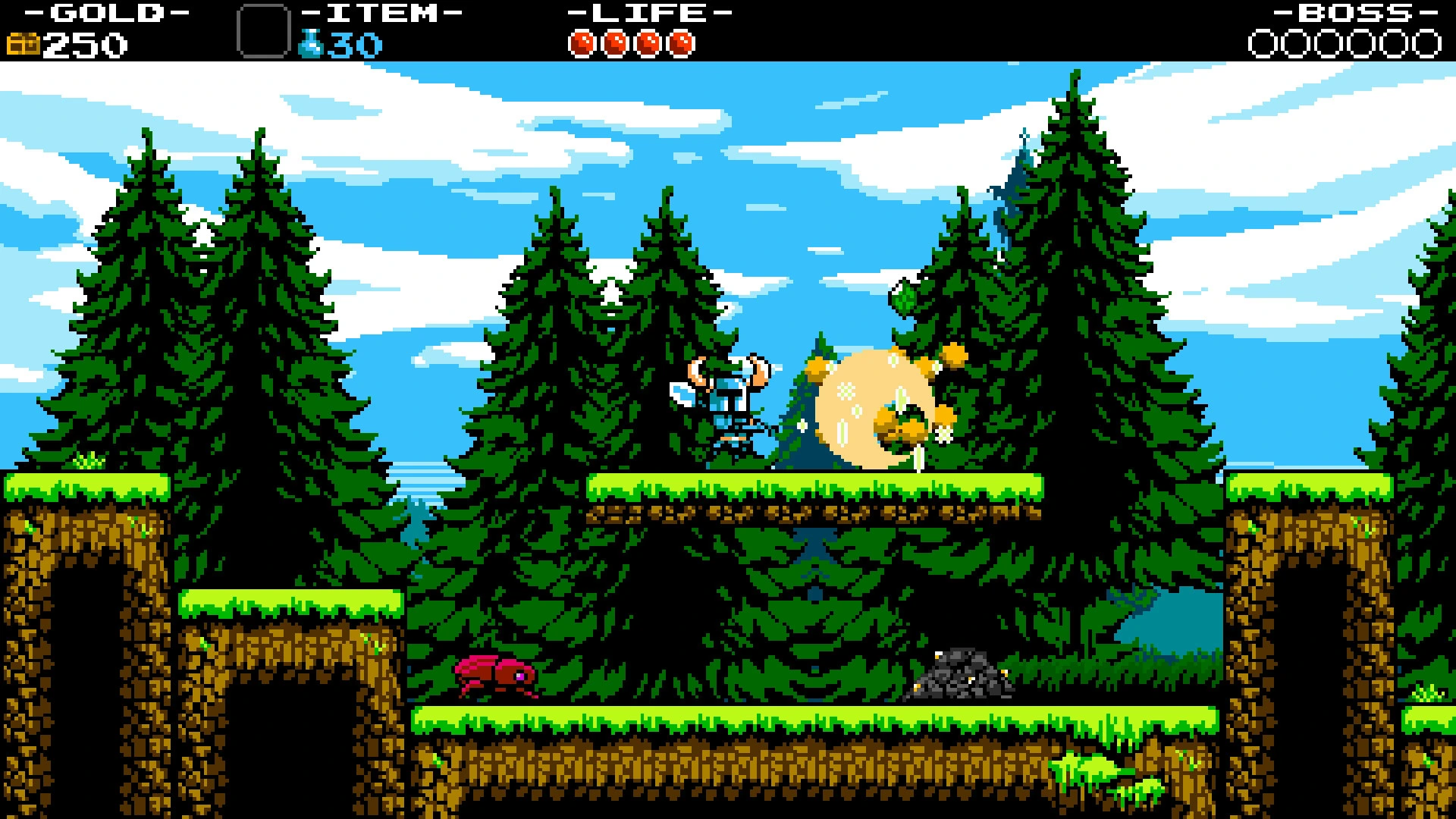

| Release Date | Platforms |
| 2014 | PC, PlayStation 4, Xbox One, Nintendo Switch, 3DS, Wii U |
Shovel Knight: Treasure Trove is a 2D side-scrolling platform game developed and published by Yacht Club Games. The game was released in 2014 for Microsoft Windows, Nintendo 3DS, and Wii U, and later released for other platforms such as PlayStation 4, Xbox One, and Nintendo Switch. The game features an 8-bit aesthetic inspired by classic NES games and uses pixel art to create a vibrant and charming world.
Players control the eponymous Shovel Knight, a small knight armed with a shovel as his main weapon, as he travels through levels filled with enemies, obstacles, and secrets. The game features a variety of levels with unique themes and bosses to fight, as well as hidden areas and treasures to discover. The game also features a variety of upgrades and abilities that the player can acquire, such as new weapons and magic spells, that can be used to defeat enemies and overcome challenges. Shovel Knight: Treasure Trove includes several additional campaigns featuring different characters, adding even more content to an already fantastic game.
Dwerve
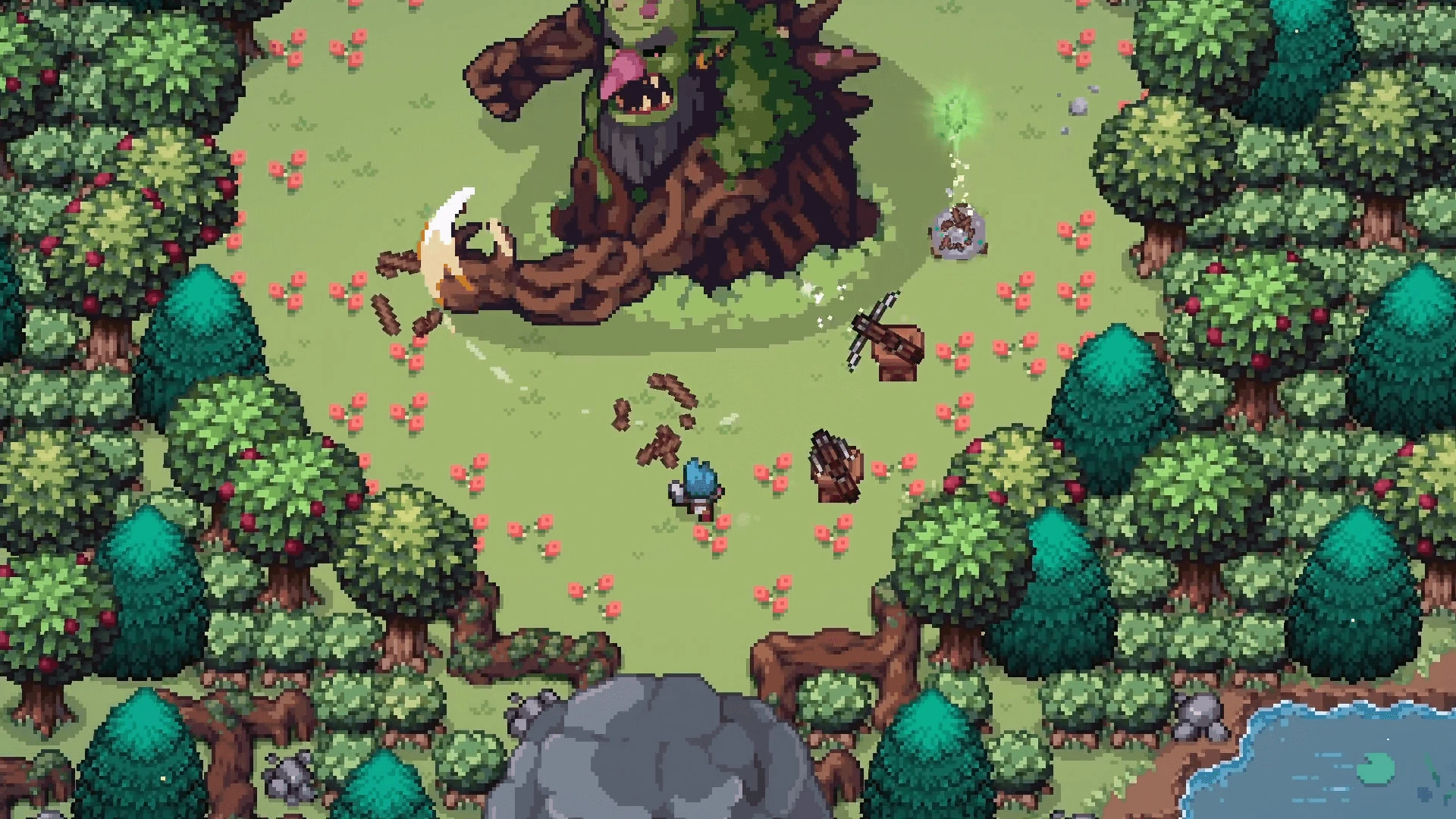

| Release Date | Platforms |
| 2022 | PC, Nintendo Switch |
Dwerve is a pixel art game that blends tower defence and dungeon crawling mechanics with RPG elements. Developed by Half Human Games, the game follows a young dwarf named Pointy who sets out on an adventure to save his village from a swarm of insectoid machines. As players progress through the game, they can upgrade their weapons and equipment, build defensive structures, and unlock new abilities to help them survive the game’s challenging battles.
Dwerve features a beautiful retro-style pixel art aesthetic, with lush, detailed environments and charming character designs. The game also has a rich storyline, engaging gameplay, and a unique blend of genres that will appeal to RPGs and tower defence game fans.
Octopath Traveler


| Release Date | Platforms |
| 2018 | PC, Nintendo Switch, Xbox One |
Octopath Traveler is a pixel art game developed by Square Enix and Acquire, originally released for Nintendo Switch in 2018 and later for PC in 2019. This Japanese role-playing game (JRPG) features a unique visual style that combines pixel art with modern lighting effects, creating a nostalgic yet modern aesthetic.
Octopath Traveler follows the journey of eight different characters, each with their own storylines and abilities, as they explore the world of Orsterra. The game features turn-based combat and allows players to choose their own path through the story, making it a great choice for fans of non-linear gameplay and immersive storytelling.
Owlboy
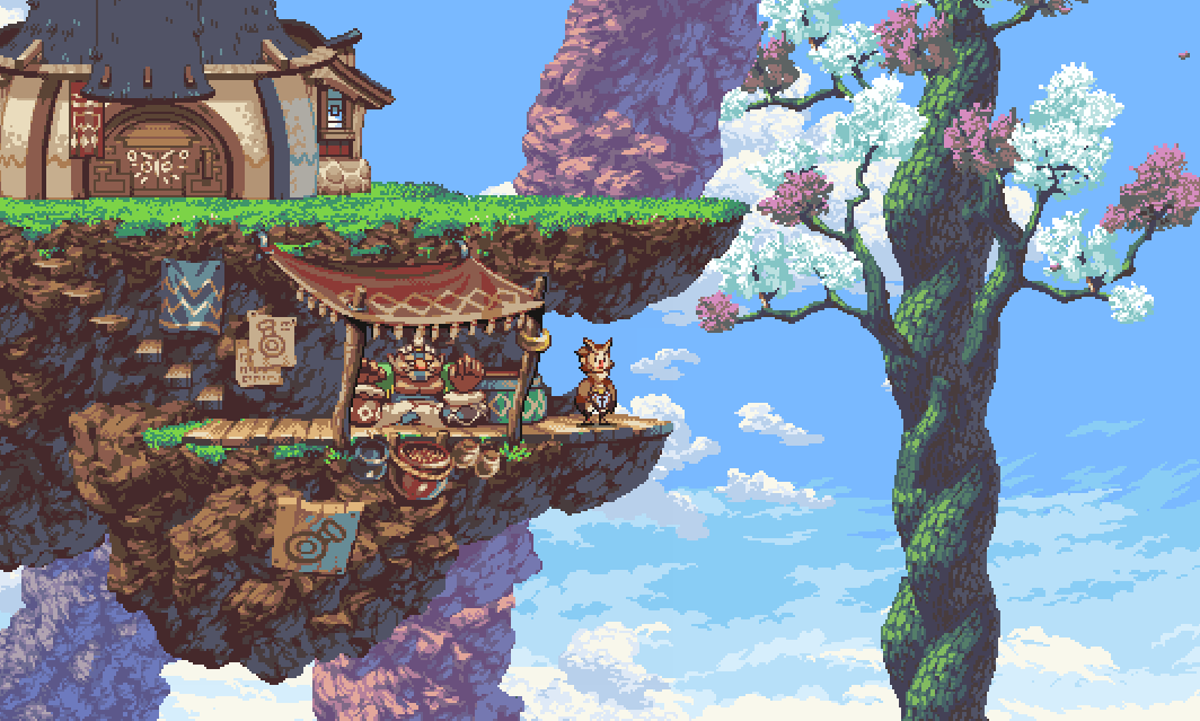

| Release Date | Platforms |
| 2016 | PC, Nintendo Switch, Xbox One, PlayStation 4 |
Owlboy is a pixel art action-adventure game developed and published by D-Pad Studio. The game was released on PC in 2016 and later on various consoles, including Nintendo Switch, PlayStation 4, and Xbox One.
In the game, players take control of a young boy named Otus, a mute owl-human hybrid. Otus embarks on an adventure to save his village from a group of pirates who are threatening to take over. The game features a beautiful pixel art world with vibrant colors and detailed character designs. The gameplay involves exploration, platforming, and combat against various enemies. The story is told through dialogue between the characters and the game’s cutscenes. Owlboy has received critical acclaim for its art style (which is a strong candidate for the best pixel art graphics ever), story, and gameplay, making it one of the most popular and beloved pixel art games of recent years.
Blasphemous
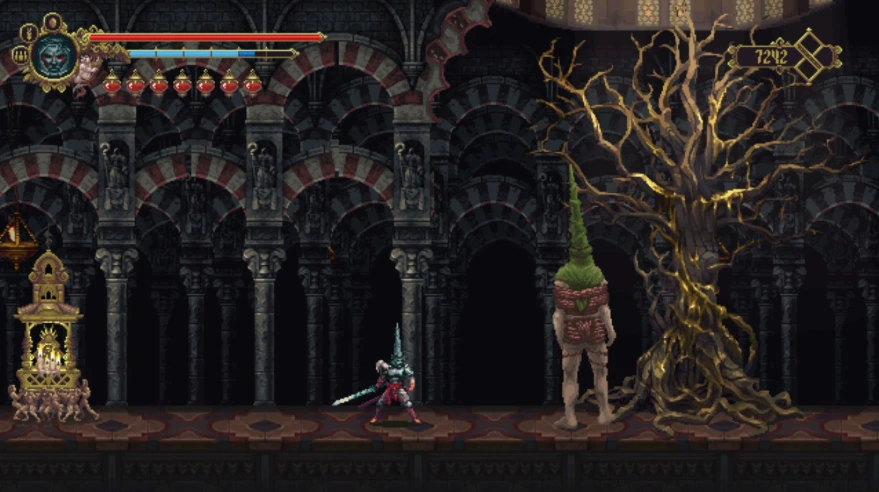

| Release Date | Platforms |
| 2019 | PC, Nintendo Switch, Xbox One, PlayStation 4 |
Blasphemous is a pixel art game developed by The Game Kitchen and published by Team17. The game was released in 2019 and is available on various platforms, including Microsoft Windows, PlayStation 4, Xbox One, and Nintendo Switch.
Blasphemous is a 2D platformer game set in a dark, gothic world filled with grotesque and horrifying enemies. The game features an intricate combat system where the player has to time their attacks and dodges carefully. It also has a deep but cryptic narrative that is conveyed through its world and characters.
The game has been praised for its stunning pixel art graphics, which are highly detailed and intricate, and its haunting soundtrack. Blasphemous has won multiple awards and has been praised for its challenging gameplay, unique setting, and emotional storytelling.
Black Skylands


| Release Date | Platforms |
| 2021 | PC, PlayStation 5, PlayStation 4, Xbox One, Xbox Series X and Series S, Nintendo Switch |
Black Skylands is a top-down shooter and action RPG developed by Hungry Couch Games. The game is set in a beautiful, hand-drawn world where players take on the role of Eva, a skilled pilot who must explore the floating islands of the Black Skylands and fight against the enemy faction known as the Swarm. The game combines elements of classic arcade shooters with RPG mechanics, allowing players to customize their airship, weapons, and skills to match their playstyle.
The game’s narrative revolves around Eva’s journey to save her homeland from the Swarm, who have taken control of the islands and brought chaos and destruction to the once-peaceful skies. Along the way, players will encounter a diverse cast of characters, each with their own unique stories and abilities. The game’s stunning art style and immersive sound design combine to create a captivating atmosphere that draws players into the world of Black Skylands. With its deep crafting system, engaging combat mechanics, and expansive open world to explore, Black Skylands promises to be an exciting addition to the pixel art game genre.
Dead Cells


| Release Date | Platforms |
| 2018 | PC, PlayStation 5, PlayStation 4, Xbox One, Xbox Series X and Series S, Nintendo Switch, Android, iOS |
Dead Cells, developed by Motion Twin, is a critically acclaimed rogue-like metroidvania game that has taken the gaming world by storm. Set in a dark and hauntingly beautiful world, players assume the role of an immortal prisoner on a treacherous quest for freedom through procedurally generated levels. The game’s fast-paced combat mechanics, combined with its challenging enemies and powerful weaponry, create an exhilarating and addictive gameplay experience that keeps players engaged and on their toes.
What sets Dead Cells apart is its unique approach to death, offering players a constant sense of progression. With each playthrough, you gather valuable resources and permanent upgrades, making subsequent attempts feel fresh and rewarding. The intricate level design, handcrafted pixel art, and haunting soundtrack all contribute to an atmospheric experience that draws players deeper into its mysterious world. Dead Cells is a masterful blend of nostalgia and innovation, earning its place as one of the most celebrated indie games of its time.
Starbound
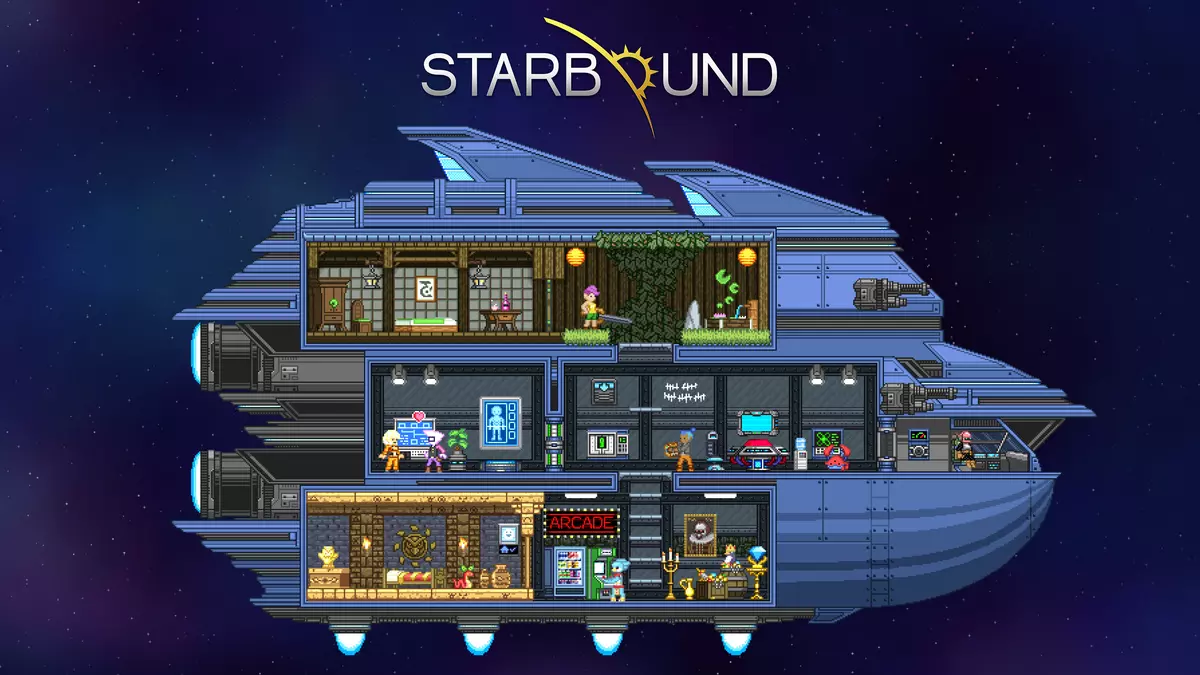

| Release Date | Platforms |
| 2016 | PC |
Starbound, developed by Chucklefish, is an enchanting and ambitious sandbox game that takes players on an intergalactic journey of exploration and adventure. Set in a procedurally generated universe, players become the captain of a customizable spaceship, traveling through diverse planets filled with unique landscapes, creatures, and mysteries. As they gather resources, complete quests, and interact with various alien civilizations, players uncover the secrets of the universe while shaping their own path and destiny.
What distinguishes Starbound is its boundless creativity and freedom. Players can build and terraform their settlements, craft intricate items, and even create their own custom missions and storylines. The game’s charming pixel art, delightful soundtrack, and ever-expanding content have captivated players, making Starbound an enduring favorite in the sandbox gaming genre. Its vibrant and imaginative world invites players to immerse themselves in an epic space odyssey limited only by their own imagination.
Children of Morta
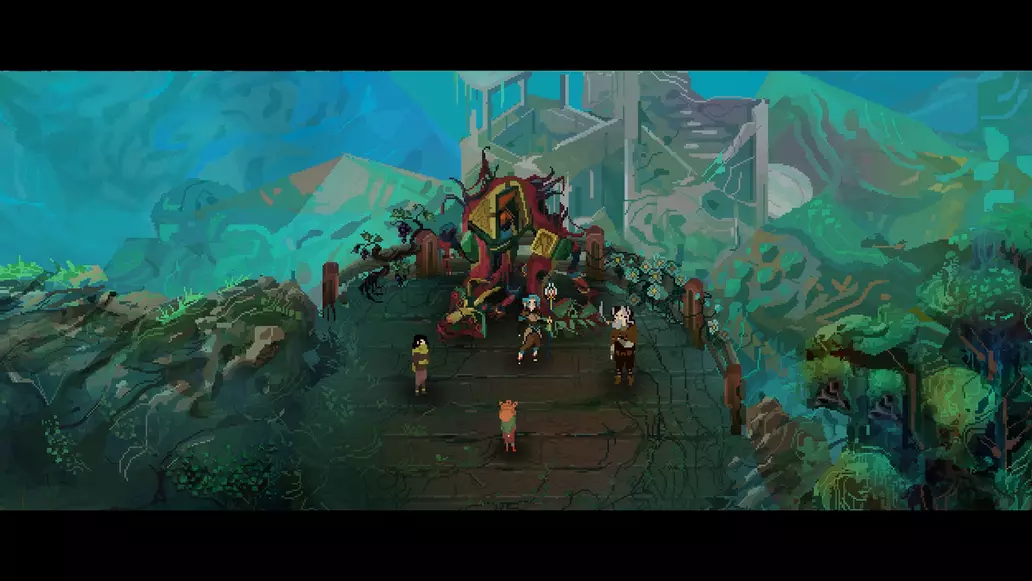

| Release Date | Platforms |
| 2019 | PC, PlayStation 4, Xbox One, Nintendo Switch |
Children of Morta, developed by Dead Mage Inc., is an emotionally gripping action RPG that weaves a captivating narrative around the Bergson family. Players embark on an unforgettable journey, guiding different family members through the cursed land of Rea, battling hordes of monsters and uncovering dark secrets that threaten their homeland. The game beautifully balances heartwarming family dynamics with intense combat and exploration, creating a deeply immersive and emotionally resonant experience.
What sets Children of Morta apart is its seamless integration of storytelling and gameplay. Each Bergson family member possesses unique abilities and playstyles, allowing players to switch characters and adapt to various challenges. The lush pixel art visuals and a hauntingly beautiful soundtrack further enhance the game’s enchanting atmosphere. As players delve deeper into the story and connect with the Bergsons, they forge an unbreakable bond with these heroic characters, making Children of Morta a truly extraordinary and unforgettable gaming experience.
Castlevania: Symphony of the Night


| Release Date | Platforms |
| 1997 | PlayStation, Sega Saturn, Xbox 360, PlayStation Portable, PlayStation 4, Android, iOS |
Castlevania: Symphony of the Night is a classic example of pixel art in gaming. Released in 1997, it pushed the boundaries of 2D visuals on the PlayStation. The game’s detailed sprites, intricate backgrounds, and smooth animations brought the dark and gothic world of Dracula’s castle to life. Its iconic protagonist, Alucard, moved with grace and fluidity, making Symphony of the Night a prime example of how pixel art can create an enduring and atmospheric game world.
Chrono Trigger
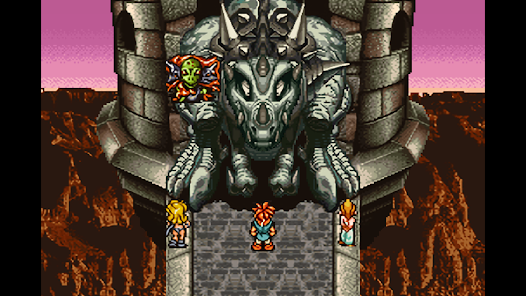

| Release Date | Platforms |
| 1995 | Super NES, PlayStation, Nintendo DS, i-mode, iOS, Android, PC |
Chrono Trigger, a timeless RPG, is celebrated not only for its captivating storyline but also for its beautifully crafted pixel art. Developed by a dream team of Japanese RPG designers, including Hironobu Sakaguchi and Akira Toriyama, the game’s character designs, environments, and spell effects are a testament to the artistry of pixel-based visuals. The game’s visuals have aged gracefully, and its charming characters and vibrant settings continue to captivate players.
Vampire Survivors


| Release Date | Platforms |
| 2022 | PC, Xbox One, Xbox Series X/S, Nintendo Switch, Android, iOS |
Vampire Survivors is a modern pixel art gem known for its challenging and fast-paced gameplay. Despite its minimalist aesthetic, the game’s pixel art contributes to its frantic and immersive experience. The pixel-perfect precision required for movement and combat is both a gameplay challenge and a testament to the importance of pixel art in modern indie gaming.
Stardew Valley
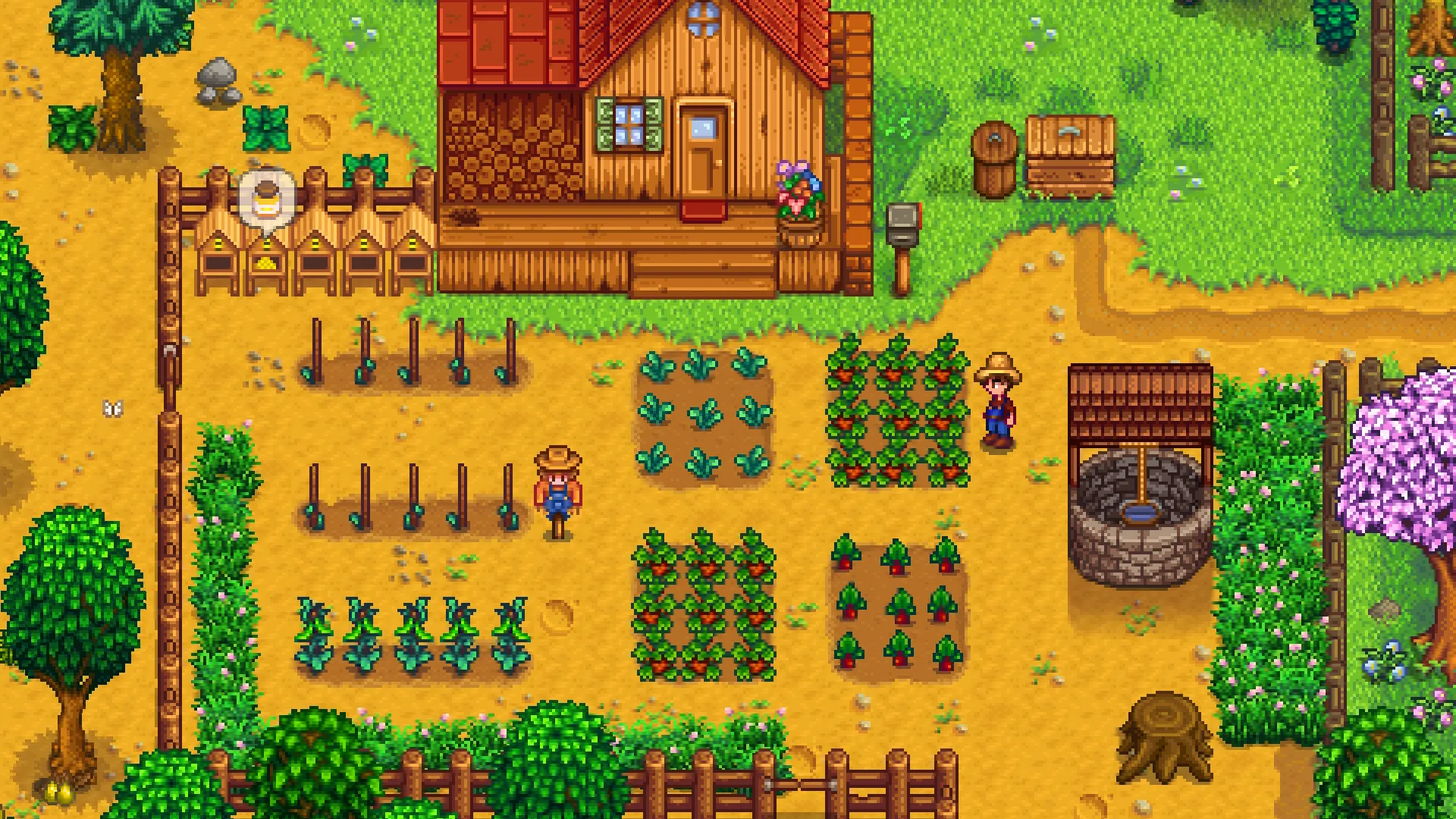

| Release Date | Platforms |
| 2016 | PC, PlayStation 4, Xbox One, Nintendo Switch, PlayStation Vita, iOS, Android |
Stardew Valley, created by a solo developer, showcases the enduring charm of pixel art in the indie gaming scene. The game’s colorful and detailed pixel art brings the farming town of Pelican Town to life, evoking a sense of nostalgia for classic SNES-era RPGs. The pixel art in Stardew Valley is not just about aesthetics; it plays a crucial role in crafting an inviting and cozy world for players to get lost in.
Papers, Please
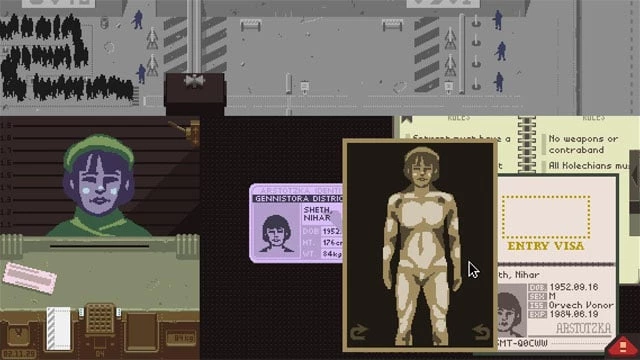

| Release Date | Platforms |
| 2013 | PC, iPad, Vita, Android, iPhone |
Papers, Please is a unique and thought-provoking game that uses pixel art to deliver a powerful narrative. The stark and utilitarian pixel art style reinforces the oppressive atmosphere of a border checkpoint, where players take on the role of an immigration officer. The game’s visuals, while seemingly simple, effectively convey the moral dilemmas and hardships faced by its characters.
EASTWARD


| Release Date | Platforms |
| 2021 | PC, Switch, Xbox One |
EASTWARD is a more recent addition to the pixel art genre, and it shines with its beautifully handcrafted visuals. The game’s pixel art breathes life into its post-apocalyptic world, featuring stunning landscapes, quirky characters, and intricate details that make exploration a joy. EASTWARD demonstrates how pixel art can continue to evolve and captivate players in the modern gaming landscape.
Warhammer 40,000: Boltgun
Warhammer 40,000: Boltgun excels as a pixel art game, immersing players in the grim and dystopian universe of Warhammer 40K. The pixelated visuals capture the essence of the Warhammer world, portraying intricate details of the characters and environments. The pixel art style, combined with strategic gameplay, enhances the overall experience, making it a standout title in the realm of pixel art games.
Cassette Beasts
Cassette Beasts stands out with its vibrant and charming pixel art, bringing to life a world filled with imaginative creatures. The game’s pixel artistry enhances the sense of nostalgia while offering a fresh take on monster-catching gameplay. The attention to detail in the pixelated designs of the Cassette Beasts adds a layer of personality to the game, making it a delightful and visually engaging experience.
Pizza Tower
Pizza Tower showcases the creative potential of pixel art in a whimsical and entertaining platformer. The game’s pixel art style complements its quirky and fast-paced gameplay, creating a visually dynamic and captivating experience. The attention to fluid animations and expressive character designs demonstrates the versatility and charm of pixel art in delivering a lighthearted and enjoyable gaming adventure.
Triangle Strategy
Triangle Strategy combines intricate pixel art with compelling tactical gameplay, offering players a visually stunning and strategically challenging experience. The pixelated environments and character designs contribute to the game’s immersive world-building, while the strategic depth is enhanced by the clarity and precision of the pixel art. Triangle Strategy showcases how pixel art can elevate the visual and gameplay aspects of a tactical RPG.
Prodeus
Prodeus impresses with its retro-inspired pixel art and intense first-person shooter action. The game’s pixel art style not only pays homage to classic shooters but also enhances the immersive and fast-paced gameplay. The meticulously designed pixel art environments and enemies contribute to the game’s visceral and adrenaline-pumping experience, proving that pixel art can excel in delivering modern and intense gaming experiences.
Is Pixel Art a Skill?
Pixel art is not just a form of digital art but indeed a skill that requires dedication, practice, and an understanding of fundamental design principles. It involves creating intricate images pixel by pixel, often with limited color palettes. Artists skilled in pixel art possess a keen eye for detail and an ability to convey complex visuals within the constraints of a low-resolution canvas. Mastery of this art form requires a deep understanding of shading, dithering, and color theory.
Creating pixel art involves a unique process that sets it apart from other digital art forms. Artists must carefully plan and place each pixel, determining how colors interact to create desired textures and shapes. While it might seem simplistic due to its retro aesthetics, pixel art demands precision and creativity, making it a skill that requires continual refinement.
Advantages of Pixel Art Games
Pixel art games offer a nostalgic and visually striking experience that resonates with both gamers who fondly remember retro classics and newcomers drawn to the charm of the style. One major advantage is the ability to create detailed, appealing visuals while keeping file sizes manageable, making them suitable for various platforms, including mobile devices and low-spec systems.
The pixel art style also encourages creativity and unique artistic expression. Artists can experiment with limited color palettes and clever pixel placement to convey emotions, atmospheres, and even intricate scenes. This artistic flexibility, combined with the relatively simple technical requirements, has made pixel art a staple for indie game developers looking to create memorable and distinctive games.
Pixel Art in Indie Game Development
Pixel art has found a comfortable home in the realm of indie game development. Indie developers often have limited resources compared to larger studios, and pixel art’s efficient use of resources aligns well with their goals. The style’s retro aesthetics can evoke a sense of nostalgia, resonating with players who grew up playing classic games.
Furthermore, pixel art enables indie developers to focus on gameplay mechanics and storytelling without compromising on visual appeal. The approachability of pixel art allows smaller teams to create polished and engaging experiences without the need for extensive art assets or cutting-edge hardware.
In summary, pixel art is not only a skill but also a unique and advantageous art style in game development. Its technical challenges and creative potential make it a favored choice for indie developers seeking to craft memorable games that capture players’ hearts through a blend of nostalgia and innovative design.
The Resurgence of Pixel Art in Modern Gaming and Its Appeal to Players
Pixel art, a nostalgic visual style reminiscent of early video games, has experienced a significant resurgence in modern gaming. Despite the advent of sophisticated graphics technology, pixel art continues to captivate players and developers alike. Its appeal lies in its simplicity and charm, evoking a sense of nostalgia for classic gaming experiences while offering a unique aesthetic that stands out in today’s crowded market. Additionally, pixel art’s minimalist approach allows for intricate detail and creativity within limited constraints, enabling developers to convey rich narratives and evoke emotional responses through simple yet expressive visuals.
Comparison of Pixel Art Styles
Pixel art can be categorized into different styles. He most prominent ones are:
- Classic Pixel Art: This style replicates the limited color palettes and low-resolution graphics of early video game consoles and computers like the NES, Sega Genesis, and Commodore 64. It often features blocky characters and environments with simple animations.
- Modern Pixel Art: This style retains the essence of classic pixel art but incorporates higher resolutions and more sophisticated techniques. Artists often use larger canvas sizes, more colors, and smoother animations while still maintaining a pixelated aesthetic.
- Neo-Retro Pixel Art: Combining elements of classic and modern pixel art, neo-retro pixel art blends nostalgic references with contemporary design principles. It may feature detailed character animations, intricate backgrounds, and advanced lighting effects while maintaining a retro-inspired visual style.
- Minimalist Pixel Art: This style focuses on simplicity and abstraction, using minimal colors and pixel counts to convey characters and environments. It often employs geometric shapes and clean lines to create recognizable imagery with a minimalist aesthetic.
- Experimental Pixel Art: This category encompasses unconventional approaches to pixel art, including glitch art, abstract compositions, and non-traditional color palettes. Artists in this style often push the boundaries of pixel art to create unique and thought-provoking visual experiences.

